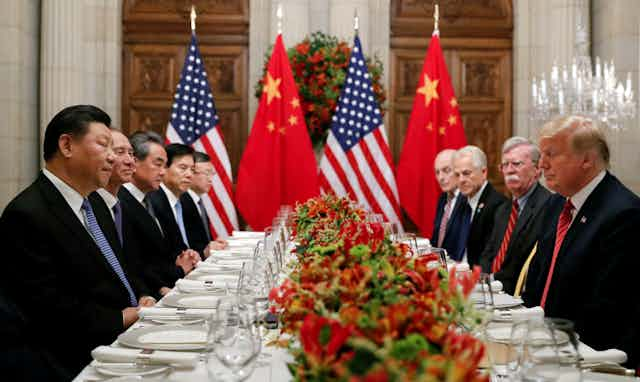US and China Deescalate Trade: Tariffs Reduced Massively
On Monday, a significant de-escalation in the global trade environment was witnessed. The two largest economies on earth, the United States and China, declared a significant reduction in their mutual tariffs. Following discussions held in Geneva over the weekend, these steps have been instigated to be active for the next 90 days. This development has come at the heels of escalating economic unrest between the two countries for several months.
Upon his return to the office, U.S. President Donald Trump engaged in a comprehensive trade war against most of the United States’ alliances and competitors. However, this recent development might signify a turning point in the global trade dynamics. A joint statement issued by the two governments indicated a reduction of U.S. inward tariffs on Chinese commodities will be seen from 145% to 30%.
Similarly, China has mirrored U.S. efforts by deciding to lessen its tariffs on U.S. imports from a staggering 125% to 10%. These downscaled tariffs are expected to kick into gear by the 14th of May and will remain in effect over a preliminary phase of 90 days. With these actions undertaken, the two nations intend to design a mechanism for ongoing discourse regarding their economic and trade ties, as stated in the joint declaration.
Mr. Bessent, addressing attendees in Geneva, emphasized the shared interest both nations have in cultivating balanced trade. He went on to assure his listeners that the U.S. would continue steering the economy in that direction. A stable mechanism is in the pipeline to avert the repercussions of unfortunate escalations, Bessent added.
The discussions between the two delegations produced a shared opinion. Neither party was desirous of a decoupling, as emphasized by Mr. Bessent. The economic ramifications of the reciprocal tariffs caused a precipitous fall in export levels and inflated prices. These financial repercussions began to be significantly felt by both economies, specifically inciting havoc within the U.S. stock and treasury markets.
President Trump, amidst mounting criticism, expressed his readiness to embrace a trade agreement last month. He spoke of the potential for negotiations to reach fruition swiftly and assured he would refrain from a tough stance during talks with China. He seemed optimistic about the road ahead, forecasting prosperity for both sides and a cooperative relationship.
This Monday saw the announcement, representing the second significant instance of Trump scaling back tariffs. This move runs counter to his economic policy, known for causing market turbulence. Earlier, on the 2nd of April, President Trump had symbolized what many deemed as ‘Liberation Day’ tariffs, against nearly every country worldwide.
These specialized tariffs appeared to be influenced by the unique calculation system relating to the trade deficit that each target nation had with the U.S., although the system’s credibility was widely debated. However, habitats devoid of human life and nations boasting a trade surplus were exempted from these tariff impositions. Post the market crash, and the looming threat of global recession, Mr. Trump revisited his decision, in turn initiating a 90-day pause, which persists till the present.
Following this pause’s initiation, President Trump has kept busy negotiating individualized trade agreements with numerous countries. Among these, the agreement with Britain certainly stands out due to its comprehensive nature, finalized this past week. Last Friday, addressing the press, Trump remained dismissive of his critics and their criticism of his methodology.
He confidently stated that the tariffs were going to be the best economic action in the country’s history. He believed this radical step had the potential to replenish the country’s wealth. As these statements indicate, despite facing a torrent of criticism, Trump remains adamantly optimistic.
With these considerable tariff rollbacks, the economies of the U.S. and China are poised at an evocative juncture. Easing tariff tensions between these prominent global players could ultimately serve to stabilize the volatile global economy, and potentially usher in a phase of economic prosperity.
However, this rollback is only a temporary fix, slated to last for an initial 90-day period. It will be interesting to observe whether these countries will extend this period or if heated tensions will resurface. This monumental decision could have far-reaching implications for both nations and the world at large.
Thus, as the discourse on economic and trade connections between the two superpowers continues and a mechanism for continued conversations is in the works, this rollback holds immense potential. Both nations are at a critical crossroads. Their decisions could potentially reshape global trade dynamics and impact international relations.
President Trump’s aggressive tariff impositions and his subsequent decision to pull back from them serve as a telling commentary on his controversial economic policy. While he continues to face criticism, Trump remains unfazed, demonstrating his steadfast belief in the effectiveness of his approach towards international trade.
The decision to reduce tariffs significantly may introduce a sense of uncertainty within international trade relations. While it is an attempt to stabilize market dynamics, its temporal nature adds a certain degree of unpredictability in an already volatile global economy.
In conclusion, the ongoing trade discussions and tariff rollbacks represent a significant shift in U.S. and China’s economic relationship. As we observe the unfolding of these developments, we stand at the brink of potential changes in global trade, holding a great promise for international economic relations.

